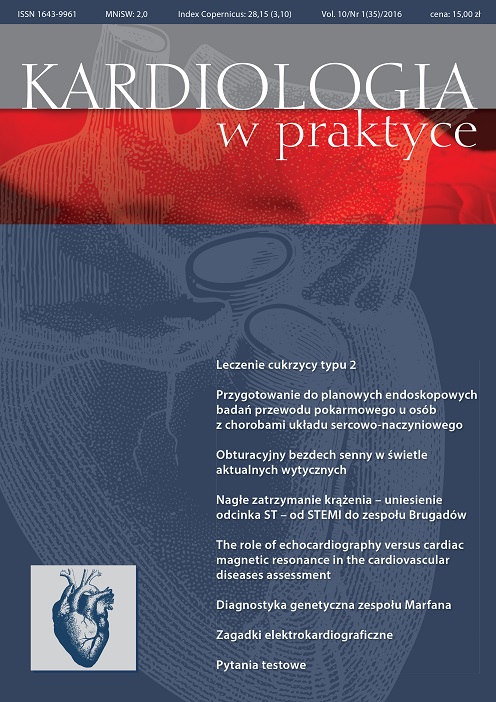Diagnostyka genetyczna zespołu Marfana Artykuł przeglądowy
##plugins.themes.bootstrap3.article.main##
Abstrakt
Zespół Marfana to jedna z najczęstszych genetycznych chorób tkanki łącznej, dziedziczona w sposób autosomalny dominujący. W większości przypadków powodowana jest przez mutacje w genie FBN1, kodującym fibrylinę-1, które prowadzą do nadmiaru transformującego czynnika wzrostu β. U chorych z zespołem Marfana występuje zwiększone ryzyko poszerzenia opuszki aorty, jak również rozwarstwienia aorty, które stanowi główną przyczynę nagłego zgonu. Aby zapobiec tym powikłaniom, trzeba szybko postawić wiarygodne rozpoznanie, co jest trudne, ponieważ obraz kliniczny zespołu Marfana może być podobny do wielu innych chorób uwarunkowanych genetycznie, które należy wykluczyć w diagnostyce różnicowej. Zgodnie ze zmodyfikowanymi kryteriami z Gandawy zespół Marfana jest rozpoznawany na podstawie określonych objawów klinicznych oraz diagnostyki genetycznej.
Pobrania
##plugins.themes.bootstrap3.article.details##

Utwór dostępny jest na licencji Creative Commons Uznanie autorstwa – Użycie niekomercyjne – Bez utworów zależnych 4.0 Międzynarodowe.
Copyright: © Medical Education sp. z o.o. This is an Open Access article distributed under the terms of the Attribution-NonCommercial 4.0 International (CC BY-NC 4.0). License (https://creativecommons.org/licenses/by-nc/4.0/), allowing third parties to copy and redistribute the material in any medium or format and to remix, transform, and build upon the material, provided the original work is properly cited and states its license.
Address reprint requests to: Medical Education, Marcin Kuźma (marcin.kuzma@mededu.pl)
Bibliografia
2. Dietz H.C., Cutting G.R., Pyeritz R.E. et al.: Marfan syndrome caused by a recurrent de novo missense mutation in the fibrillin gene. Nature 1991; 352(6333): 337-379.
3. Sakai L.Y., Keene D.R., Engvall E.: Fibrillin, a new 350-kD glycoprotein, is a component of extracellular microfibrils. J. Cell. Biol. 1986; 103(6 Pt 1): 2499-2509.
4. Detaint D., Faivre L., Collod-Beroud G. et al.: Cardiovascular manifestations in men and women carrying a FBN1 mutation. Eur. Heart J. 2010; 31(18): 2223-2229.
5. Aalberts J.J., van Tintelen J.P., Meijboom L.J. et al.: Relation between genotype and left-ventricular dilatation in patients with Marfan syndrome. Gene 2014; 534(1): 40-43.
6. von Kodolitsch Y., De Backer J., Schuler H. et al.: Perspectives on the revised Ghent criteria for the diagnosis of Marfan syndrome. Appl. Clin. Gen. 2015; 8: 137-155.
7. Hiratzka L.F., Bakris G.L., Beckman J.A. et al.: 2010 ACCF/AHA/AATS/ACR/ASA/SCA/SCAI/SIR/STS/SVM guidelines for the diagnosis and management of patients with Thoracic Aortic Disease: a report of the American College of Cardiology Foundation/American Heart Association Task Force on Practice Guidelines, American Association for Thoracic Surgery, American College of Radiology, American Stroke Association, Society of Cardiovascular Anesthesiologists, Society for Cardiovascular Angiography and Interventions, Society of Interventional Radiology, Society of Thoracic Surgeons, and Society for Vascular Medicine. Circulation 2010; 121(13): e266-e369.
8. Radke R.M., Baumgartner H.: Diagnosis and treatment of Marfan syndrome: an update. Heart 2014; 100(17): 1382-1391.
9. Hilhorst-Hofstee Y., Rijlaarsdam M.E., Scholte A.J. et al.: The clinical spectrum of missense mutations of the first aspartic acid of cbEGF-like domains in fibrillin-1 including a recessive family. Hum. Mutat. 2010; 31(12): E1915-E1927.
10. Gillis E., Kempers M., Salemink S. et al.: An FBN1 deep intronic mutation in a familial case of Marfan syndrome: an explanation for genetically unsolved cases? Hum. Mutat. 2014; 35(5): 571-574.
11. Collod G., Babron M.C., Jondeau G. et al.: A second locus for Marfan syndrome maps to chromosome 3p24.2-p25. Nat. Genet. 1994; 8(3): 264-268.
12. Mizuguchi T., Collod-Beroud G., Akiyama T. et al.: Heterozygous TGFBR2 mutations in Marfan syndrome. Nat. Genet. 2004; 36(8): 855-860.
13. Byers P.H.: Determination of the molecular basis of Marfan syndrome: a growth industry. J. Clin. Invest. 2004; 114(2): 161-163.
14. Neptune E.R., Frischmeyer P.A., Arking D.E. et al.: Dysregulation of TGF-beta activation contributes to pathogenesis in Marfan syndrome. Nat. Genet. 2003; 33(3): 407-411.
15. Loeys B.L., Dietz H.C., Braverman A.C. et al.: The revised Ghent nosology for the Marfan syndrome. J. Med. Genet. 2010; 47(7): 476-485.
16. Maher J.W., Hollenbeck J.I., Sierakowski N. et al.: Effects of biocarbonate perfusion on lower esophageal sphincter response to feeding. Surg. Forum 1975; 26: 366-368.
17. Sheikhzadeh S., Kade C., Keyser B. et al.: Analysis of phenotype and genotype information for the diagnosis of Marfan syndrome. Clin. Genet. 2012; 82(3): 240-247.
